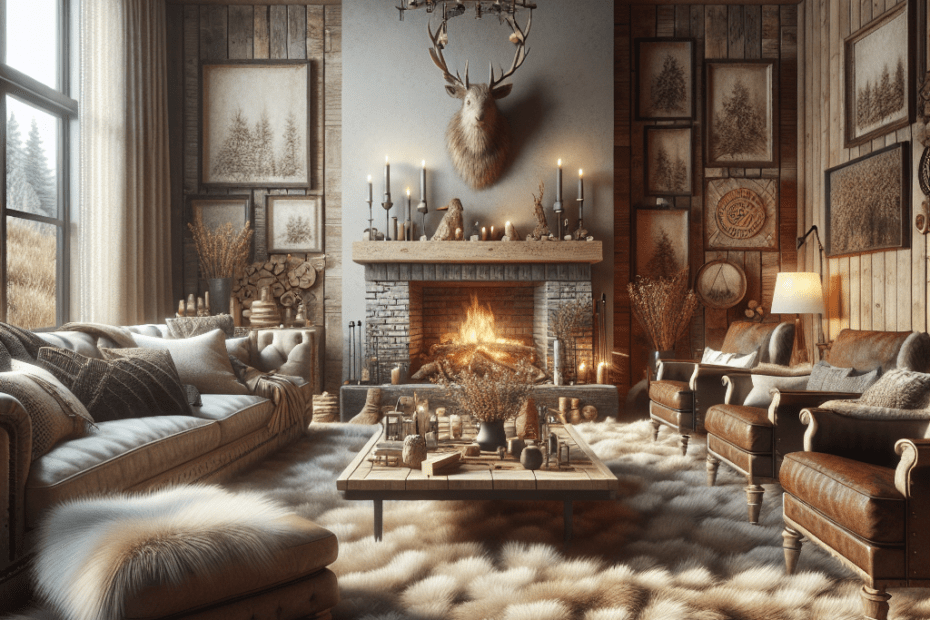“`html
Creating the perfect rustic living room with cozy textures combines timeless elements that bring warmth and charm into any space. Many people find themselves drawn to the inviting aura and natural materials that rustic décor offers. By mixing elements such as wood, stone, fabrics, and accessories, they can achieve a living room space that is not only visually pleasing but also cozy and functional.
People desire a space where they can relax and unwind, feeling at home amidst the hustle and bustle of everyday life. Rustic elements are steeped in earthy, comforting tones, making them a popular choice for those looking to escape into tranquility. The key to achieving this inviting aesthetic lies in a careful blending of textures and materials that provide warmth, character, and comfort.
Understanding Rustic Aesthetics
Rustic is characterized by its natural, simplistic charm. It often includes heavy use of wood, raw materials, and textures that convey a sense of the great outdoors inside the home. This style encourages a feeling of enduring comfort and rugged elegance, often incorporating imperfections as part of its charm.
Designers suggest using between 60% to 90% of natural materials to create a rustic setting (source: Home Decor Trends Magazine). >With this emphasis, they harness the innate beauty of wood grains, stone surfaces, and earthy fabrics like wool and cotton.
Incorporating Cozy Textures
While the base of a rustic living room setup often revolves around sturdy materials like wood and stone, the introduction of cozy textures is what makes the room inviting. They often use layers of different fabric types to create depth and interest. Soft throws, plush pillows, and rugs made of natural fibers add much-needed warmth.
Furniture Selection for a Rustic Living Room
When choosing furniture for a rustic space, many prefer the solid, enduring feel of reclaimed wood or upcycled pieces. They not only align with the rustic theme but also incorporate an eco-friendly approach by reusing materials. Upholstered furniture in neutral tones with durable fabrics can add comfort without detracting from the design’s simplicity.
| Material | Characteristics |
|---|---|
| Reclaimed Wood | Sustainable, rich textures, and character-filled |
| Stone | Natural elegance, durable, and varies in appearance |
| Linen | Soft, breathable, and naturally textured |
| Leather | Durable, adds warmth, and develops character over time |
Color Palette Considerations
The color palette in a rustic living room focuses on muted, earthy hues. Shades of brown, beige, cream, and grays are often the foundation. They might introduce pops of green, burnt orange, or deep reds to mimic nature’s palette and add visual interest.
Lighting in a Rustic Living Room
Achieving the perfect ambiance in a rustic living room includes thoughtful lighting solutions. Many choose lighting fixtures made from wrought iron, copper, or brass to complement the rustic materials. Warm, soft lighting enhances the feeling of coziness and accentuates the room’s textures and tones.
The use of layered lighting, such as a combination of overhead lights, lamps, and candlelight, can soften the room and highlight different areas. According to a survey by Lighting Trends Report, 75% of people notice improved ambiance with layered lighting approaches (source: Lighting Trends Report).
Adding Personal Touches
Finally, to truly personalize their rustic living room with cozy textures, they incorporate personal touches. Vintage finds, family heirlooms, or handcrafted items add unique stories and bring warmth that standard decor pieces cannot. It’s these small personal elements that often create an inviting, lived-in feel.
Key Takeaways
- Rustic living rooms thrive on natural materials; aim for 60%-90% natural elements like wood and stone.
- Layering of textures with throws, pillows, and rugs adds comfort and warmth to the space.
- Furniture should emphasize solid, reclaimed, or upcycled materials.
- Earthy color palettes with occasional pops of color maintain a connection with nature.
- Lighting is crucial; opt for warm tones using a mix of fixture materials and layer sources.
FAQs
- Can they use modern items in a rustic living room?
Yes, although modern items must harmonize with rustic materials, adding sleek touches without overpowering the natural elements. - How can they add more personality to a rustic living area?
By including vintage finds, personal heirlooms, or original artwork, they can enhance personality and warmth. - Are there budget-friendly ways to achieve a rustic look?
Yes, they can use DIY projects, thrift store finds, or repurpose existing furniture with a coat of paint or new upholstery. - What are some practical tips for lighting a rustic space?
Incorporating multiple lighting layers, using materials like wrought iron, and opting for warm bulbs can enhance the ambiance. - Should they focus on a single type of wood?
Mixing different types of wood can add depth and interest, but they should aim for complementary tones to maintain harmony.
“`
This article offers a guide to creating a rustic living room using cozy textures, focusing on choices that enhance warmth and charm. Readers learn the importance of textures, suitable materials, and elements such as lighting, enriching their understanding of rustic aesthetics.
